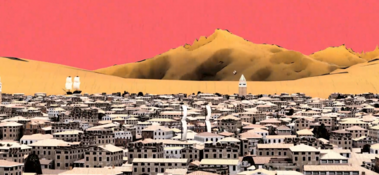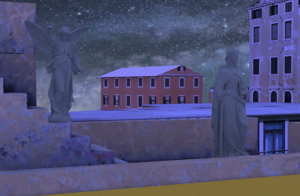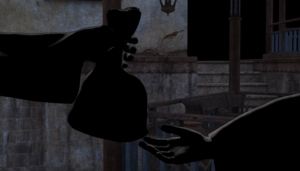Spiderjjr45 (talk | contribs) (→About) |
Spiderjjr45 (talk | contribs) |
||
| Line 58: | Line 58: | ||
=== [[The Beggar's Bodega]] === | === [[The Beggar's Bodega]] === | ||
=== PussyCat Club === | |||
Having opened on 10/2/984 [[PR]], the Pussycat club was located in the Alderhall precinct on Kettle Road. It opened with a boisterous opening ceremony fundraiser which was meant to benefit the veterans of the ongoing [[The War of Many Names|War of Many Names]]. The Club was full of gambling opportunities and was the largest casino in the city upon opening. When asked about it, the manager Vardan Lankila (a secret [[vampire]] himself) said:<blockquote>''This is a new foundation of gaming and leisure in the heart of Al'Adeaf, and they provide so much benefit to the community here, and we wanted to latch on to that as we open the new facility and being part of giving back to the community in Flaughtland''</blockquote>There is also live entertainment and a bar on the second floor of the casino. The bottom floor has a capacity for nearly 100 gamblers at a time, and the casino itself only opens after 8:00 PM every day (partially to accommodate the secret vampire running the place) | |||
== Behind the Screen == | == Behind the Screen == | ||
Revision as of 03:16, 30 January 2024

Al'Adeaf (founded as Denaria, after Waukeen) is a an ever-sinking city and trade hub in the central Pteris area, linking much of the southern and northern parts of the continent together in commerce and culture. It was the second largest of The Seven Cities, a loose federation of cities in central Pteris.
Citizens from Al'Adeaf are often called `Sinkish people.
History
A City of Statues (999 PR)
Almost a thousand years ago, the “city” of Denaria was nothing more than several dozen squalid huts perched on a few islands in the fine granular sands of the Delta Serpentine. The city’s most worshiped goddess, Waukeen, soon pushed the mountains aside to provide large, flat, and fertile land for settling. Times have changed: close to 100,000 people dwell here now and the population soars during festivals or major market days. Long since renamed Al'Adeaf (Trudgeon for "Ever Sinking") the city looks westward onto a the dangerous and mysterious Badlands of Pteris, and still stands by its merchant goddess who promotes trade and profit. Al'Adeaf is the second largest city of The Seven Cities, a trade union formed by several cities on the Pteris continent and wields unmatched economic power among the seven.

In Al'Adeaf, the ringing of bells occasionally drowns out the din of endless hammering and the cries of merchants hawking their wares. Pennants of golden sandblasted coins (depicting a white Aarakocra) flutter from rooftops and poles. Priests and merchants are everywhere, statues adorn every building in sight, wild animals burrow and crawl on and beneath hundreds of stone or wooden bridges, and brightly painted buildings with breathtaking architecture ignominiously stand half-sunken into the sand. Say what you want about the heat or the smell, it’s a memorable and beautiful city.
About

The People
Al’Adeaf is full of families who have immigrated over many centuries, often intending to visit for a few weeks and choosing to settle there instead. Appearance varies amongst the population, with taller stature and darker skin tones prevailing in Al’Adeaf’s oldest families, physical traits passed down from the ancient Snobbite Regality. A good number of 'Sinkish, however, carry the traits of the northern Hobgoblins, including orange-red skin, large ears, and stout faces. Al’Adeaf takes great pride in considering itself cosmopolitan — the citizens may pay close attention to the appearance of wealth and social class, but discrimination based on race, color, or gender is considered heretical by the church and is strongly discouraged by the community.
‘Sinkish organizations tend towards a matriarchy, especially in the church; as a rule of thumb in Al’Adeaf, women are in positions of prestige and power as much as or more than men.
Societies
Like the similarly ghost-filled city of Ahol, Al'Adeaf could be broken up into important factions which each ran different parts of the city. It was possible for heroes living in or visiting the cities to have either positive or negative relationships with these groups, which could wildly influence how much help (or hinderance) they found as they went about their business in the busy streets.
The most prominent factions included:
- Ancient Snobbite Nobility: Dissolute but infinitely proud, clinging to their social graces and ancestral superiority within their crumbling mansions.
- Church of Waukeen, goddess of Commerce: every exchange of money is a prayer to her sly wisdom and obsession with trade that defines the city itself. Her priests are moneylenders who hunt down Sorcerers and carry out her will.
- City Watch: these poor bastards are under-funded, under-respected, and the hardest working employees in Al’Adeaf. They’re responsible for enforcing order, solving murders, and bringing the guilty to the gallows.
- Commoners: no one remembers the underclass, but the commoners look out for their own, and there’s a lot more poor in Al’Adeaf than there are nobles. A terrifying force when roused.
- The Guild of Architects and Canal-Watchers: despite rumors that guildmembers often die young from disease and injury, this powerful guild ensures Al’Adeaf’s architectural stability, and thus enjoys significant political sway within the city.
- Mercanti: The new-money nobility of Al’Adeaf, church-blessed families whose iron grip on specific guilds brings in the trade that powers the city.
- Mercenaries (including House Armies): Hard-living professional warriors who stay loyal as long as their pay doesn’t run out, mostly Hobgoblins.
- Monstrosities: Most people have never seen one, but there are rumors that a loose community of serpentine folk live underneath Al’Adeaf. They’re unlikely to have Waukeen’s best interests at heart.
- Badlanders: an unorganized and unpredictable group of barbarians, travelers, tourists, professional adventurers and piratical scoundrels seeking some quick coin, coming mostly from the badlands out west.
- The Sorcerous Cabal: Sorcery is considered inhuman, unnatural, and antithetical to the grace of the goddess Waukeen. If one or more sorcerous cabals exist, they’re a threat to everything right-thinking people love.
- Thieves’ Guilds: Avoiding taxes is a mortal sin in the eyes of the goddess Waukeen, but making money is a blessing, so it’s fair to say the dozens of smugglers’ and thieves’ guilds are conflicted at best.
- The Seven Cities: Distant rulers of not just Al’Adeaf, but Ugarat and 5 other cities in central Pteris, the secret police, and the vast government bureaucracy of committees that keeps the city functioning as well as it does.
Architecture
The Statues
The most notable feature of Al'Adeaf's architecture is the unimaginable number of Funerary Statues dotted across the rooftops, porches, balconies, alleyways, and sometimes even right in the streets.
The Cityscape
The city is full of color. It’s a jumbled mess of stone spires, wooden shacks, brightly painted manor houses, grand open plazas, teeming marketplaces, roof gardens, harbors, and soaring bridges over omnipresent canals. The tallest noble towers are decorated with ancient jeweled windows of breathtaking beauty, but that doesn’t necessarily distract from the unevenly sinking hovels of the poorer districts that house many common families in a small amount of space. There are even a few remaining buildings above ground from ages of sorcerous wonders, made from unbreakable crystal or other unspeakably beautiful substances.
Al’Adeaf's architects have a taste for the classical. Columns project strength, and strong foundations distract from sinking edifices. Among the clean lines are overwrought gothic windows accompanied by exquisite stained glass. The Aarakocra motif is everywhere, jumbled in among gargoyles and thousands upon thousands of funerary statues. Embossed Aarakocras decorate stone pathways between marketplaces, enormous stone aarakocra statues grace the apex of Mercanti rooftops, and Commoners scratch Aarakocra into their shacks hoping for a small taste of Waukeen's Blessing.
With land at a premium, locals take advantage of height. Laundry lines dangle from rooftops 80 feet in the air. The outsides of solid stone towers become a warren of rickety wooden ladders, hand-built platforms, and cantilevered walkways as people try to conjure up more space from thin air. Too many Commoners live in these precariously placed wooden shacks, hoping not to crash to the ground during one of the many storms that sweep in from the ocean. Similarly, there are those who take advantage of depth. Those with the least coin often live in moldy and leaking sub-basements below ground, clambering up five or six stories each morning just to reach street level. Collapses, floods, and fires in such dwellings are usually deadly.
Public and private gardens are a symbol of wealth and power. Those who can afford it prefer roof gardens of rare and exotic flowers, but you’re likely to come across small hidden (and well-defended) vegetable gardens grown on other people’s roofs by those who need the food most. Hedge animals are currently fashionable on the estates of the rich; hedge mazes are so last generation. More than one small island is entirely given over to public gardens, with any building within their borders deemed illegal.
Buildings normally lose about 8 cm to the sink each year, or roughly one floor per generation, but a sudden sink is not an unheard-of phenomenon; if you’re tremendously unlucky, a laundry line a comfortable story up today might lie on the ground tomorrow. Sinking buildings add complications, with sidewalks of varying heights and stairs leading up to (or down to) a building’s current front door. Architects work constantly to repair, modify and reinforce buildings.
All but the most recent buildings reach deeper underground than they do vertically above street level. Descending through usually flooded basements brings you back through the building’s history one generation at a time. Many such levels are flooded with quicksand, but sometimes good drainage, airtight construction or ancient pumps keep most of the sand out. Anything might be forgotten down there, and it isn’t unusual to discover that your supposedly secure basements are being used as an underground highway by smugglers. Paranoid homeowners pay architects to seal off their basements and then live in a state of denial, trying to forget that those basements even exist.
Notable Locations
The Beggar's Bodega
PussyCat Club
Having opened on 10/2/984 PR, the Pussycat club was located in the Alderhall precinct on Kettle Road. It opened with a boisterous opening ceremony fundraiser which was meant to benefit the veterans of the ongoing War of Many Names. The Club was full of gambling opportunities and was the largest casino in the city upon opening. When asked about it, the manager Vardan Lankila (a secret vampire himself) said:
This is a new foundation of gaming and leisure in the heart of Al'Adeaf, and they provide so much benefit to the community here, and we wanted to latch on to that as we open the new facility and being part of giving back to the community in Flaughtland
There is also live entertainment and a bar on the second floor of the casino. The bottom floor has a capacity for nearly 100 gamblers at a time, and the casino itself only opens after 8:00 PM every day (partially to accommodate the secret vampire running the place)
Behind the Screen
- Staying in line with the source material, many NPCs in Al'Adeaf had vaguely Italian fantasy names (ie Oscar Ghilardi, Solocone Verdi, Gaudenzio Netti)

